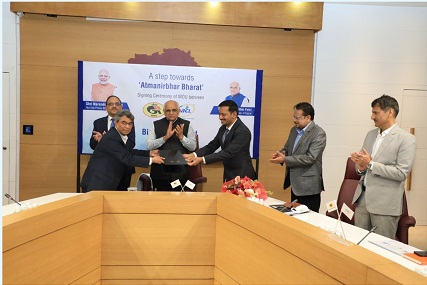GAIL (India) Limited and Gujarat Alkalies and Chemicals Limited (GACL) have entered into a Memorandum of Understanding (MoU) for setting up a 500 KLPD Bioethanol Plant in Gujarat and exploring other business opportunities of mutual interest.
The MoU was signed by M. V. Iyer, Director - Business Development, GAIL and Milind Torawane, Managing Director, GACL in the presence of Bhupendrabhai Patel, Chief Minister of Gujarat, K. Kailashnathan, Chief Principal Secretary to Chief Minister of Gujarat, Pankaj Joshi, Additional Chief Secretary to Chief Minister of Gujarat, and Manoj Jain, CMD of GAIL at Gandhinagar.
The estimated project cost is to the tune of Rs. 1,000 crore and it is expected to generate an annual revenue of approximately Rs. 1,500 crore for GACL.
This plant will be using corn/broken rice as feedstock with eco-friendly technology and it will produce 500 KLD Bioethanol, which will be used for blending in petrol. As by-products from this plant, 135 KTPA protein-rich animal feed and 16.50 KTPA of corn oil while using corn as feedstock are also expected to be produced.
This step is taken in response to the Prime Minister of India's call of Atma Nirbhar Bharat The Prime Minister has launched a roadmap for 20% Ethanol Blending in Petrol by 2025, with a view to reduce import of crude oil and save valuable foreign exchange.
Dahod, Panchmahal, Aravalli, and Mahisagar are major corn-producing districts in Gujarat and hence the project is likely to come up in one of these districts. A Detailed Feasibility Study through a third party is in progress for the project.
An estimated savings of US $70 million per year in foreign exchange outgo is expected through this project. Beyond the savings, this project will also generate direct and indirect employment for around 700 individuals.
Long term supply contracts for corn would encourage corn farming with sustainable, multi-fold income for farmers through increased productivity and assured markets. Steps will also be taken to improve the productivity of corn in the state with the help of the Maize Research Center in Godhra.
